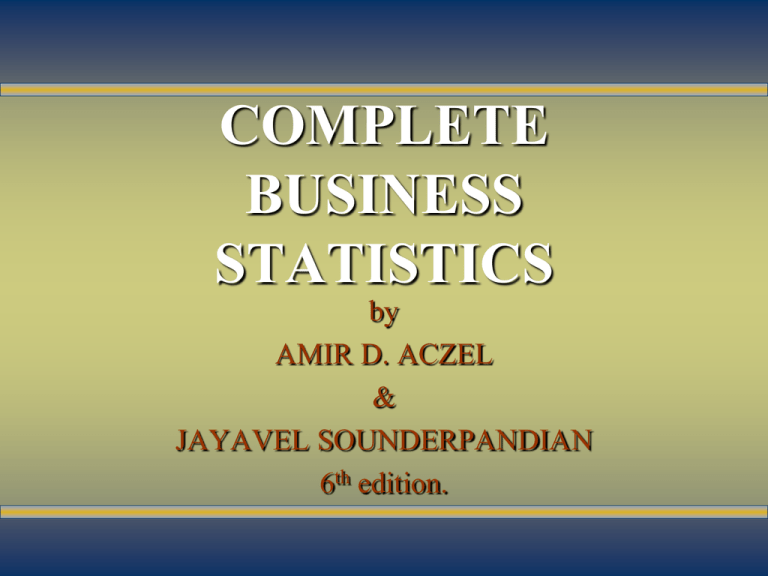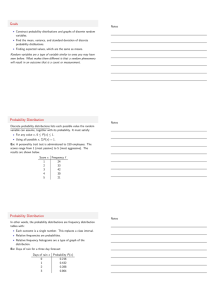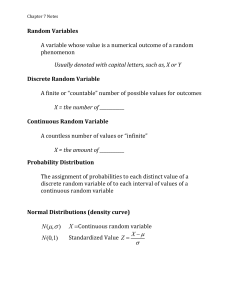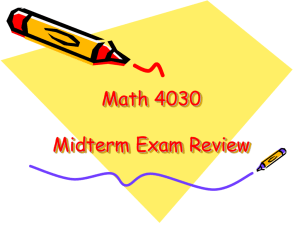COMPLETE BUSINESS STATISTICS by
advertisement

3-1 COMPLETE BUSINESS STATISTICS by AMIR D. ACZEL & JAYAVEL SOUNDERPANDIAN 6th edition. 3-2 Pertemuan 5 dan 6 Random Variables 3-3 3 Random Variables Using Statistics Expected Values of Discrete Random Variables Sum and Linear Composite of Random Variables Bernoulli Random Variable The Binomial Random Variable The Geometric Distribution The Hypergeometric Distribution The Poisson Distribution Continuous Random Variables Uniform Distribution The Exponential Distribution 3-4 3 LEARNING OBJECTIVES After studying this chapter you should be able to: Distinguish between discrete and continuous random variables Explain how a random variable is characterized by its probability distribution Compute statistics about a random variable Compute statistics about a function of a random variable Compute statistics about the sum or a linear composite of a random variable Identify which type of distribution a given random variable is most likely to follow Solve problems involving standard distributions manually using formulas Solve business problems involving standard distributions using spreadsheet templates. 3-5 3-1 Using Statistics Consider the different possible orderings of boy (B) and girl (G) in four sequential births. There are 2*2*2*2=24 = 16 possibilities, so the sample space is: BBBB BBBG BBGB BBGG BGBB BGBG BGGB BGGG GBBB GBBG GBGB GBGG GGBB GGBG GGGB GGGG If girl and boy are each equally likely [P(G) = P(B) = 1/2], and the gender of each child is independent of that of the previous child, then the probability of each of these 16 possibilities is: (1/2)(1/2)(1/2)(1/2) = 1/16. 3-6 Random Variables Now count the number of girls in each set of four sequential births: BBBB BBBG BBGB BBGG (0) (1) (1) (2) BGBB BGBG BGGB BGGG (1) (2) (2) (3) GBBB GBBG GBGB GBGG (1) (2) (2) (3) GGBB GGBG GGGB GGGG (2) (3) (3) (4) Notice that: • each possible outcome is assigned a single numeric value, • all outcomes are assigned a numeric value, and • the value assigned varies over the outcomes. The count of the number of girls is a random variable: A random variable, X, is a function that assigns a single, but variable, value to each element of a sample space. 3-7 Random Variables (Continued) 0 BBBB BGBB GBBB BBBG BBGB GGBB GBBG BGBG BGGB GBGB BBGG BGGG GBGG GGGB GGBG GGGG 1 X 2 3 4 Sample Space Points on the Real Line 3-8 Random Variables (Continued) Since the random variable X = 3 when any of the four outcomes BGGG, GBGG, GGBG, or GGGB occurs, P(X = 3) = P(BGGG) + P(GBGG) + P(GGBG) + P(GGGB) = 4/16 The probability distribution of a random variable is a table that lists the possible values of the random variables and their associated probabilities. x 0 1 2 3 4 P(x) 1/16 4/16 6/16 4/16 1/16 16/16=1 The Graphical Display for this Probability Distribution is shown on the next Slide. 3-9 Random Variables (Continued) Probability Distribution of the Number of Girls in Four Births 0.4 6/16 Probability, P(X) 0.3 4/16 4/16 0.2 0.1 1/16 0.0 0 1/16 1 2 Number of Girls, X 3 4 3-10 Example 3-1 Consider the experiment of tossing two six-sided dice. There are 36 possible outcomes. Let the random variable X represent the sum of the numbers on the two dice: x P(x)* Probability Distribution of Sum of Two Dice 3 1,3 2,3 3,3 4,3 5,3 6,3 4 1,4 2,4 3,4 4,4 5,4 6,4 5 1,5 2,5 3,5 4,5 5,5 6,5 6 1,6 2,6 3,6 4,6 5,6 6,6 7 8 9 10 11 12 1/36 2/36 3/36 4/36 5/36 6/36 5/36 4/36 3/36 2/36 1/36 1 0.17 0.12 p(x) 1,1 2,1 3,1 4,1 5,1 6,1 2 1,2 2,2 3,2 4,2 5,2 6,2 2 3 4 5 6 7 8 9 10 11 12 0.07 0.02 2 3 4 5 6 7 8 9 10 x * Note that: P(x) (6 (7 x) 2 ) / 36 11 12 3-11 Example 3-2 Probability Distribution of the Number of Switches The Probability Distribution of the Number of Switches P(x) 0.1 0.2 0.3 0.2 0.1 0.1 1 0.4 0.3 P(x) x 0 1 2 3 4 5 0.2 0.1 0.0 0 1 2 3 4 5 x Probability of more than 2 switches: P(X > 2) = P(3) + P(4) + P(5) = 0.2 + 0.1 + 0.1 = 0.4 Probability of at least 1 switch: P(X 1) = 1 - P(0) = 1 - 0.1 = .9 3-12 Discrete and Continuous Random Variables A discrete random variable: has a countable number of possible values has discrete jumps (or gaps) between successive values has measurable probability associated with individual values counts A continuous random variable: has an uncountably infinite number of possible values moves continuously from value to value has no measurable probability associated with each value measures (e.g.: height, weight, speed, value, duration, length) 3-13 Rules of Discrete Probability Distributions The probability distribution of a discrete random variable X must satisfy the following two conditions. 1. P(x) 0 for all values of x. 2. P(x) 1 all x Corollary: 0 P( X ) 1 3-14 Cumulative Distribution Function The cumulative distribution function, F(x), of a discrete random variable X is: F(x) P( X x) P(i) all i x P(x) 0.1 0.2 0.3 0.2 0.1 0.1 1.00 F(x) 0.1 0.3 0.6 0.8 0.9 1.0 Cumulative Probability Distribution of the Number of Switches 1 .0 0 .9 0 .8 0 .7 F(x) x 0 1 2 3 4 5 0 .6 0 .5 0 .4 0 .3 0 .2 0 .1 0 .0 0 1 2 3 x 4 5 3-15 Cumulative Distribution Function The probability that at most three switches will occur: x 0 1 2 3 4 5 P(x) 0.1 0.2 0.3 0.2 0.1 0.1 1 F(x) 0.1 0.3 0.6 0.8 0.9 1.0 Note: P(X < 3) = F(3) = 0.8 = P(0) + P(1) + P(2) + P(3) 3-16 Using Cumulative Probability Distributions (Figure 3-8) The probability that more than one switch will occur: x 0 1 2 3 4 5 P(x) 0.1 0.2 0.3 0.2 0.1 0.1 1 F(x) 0.1 0.3 0.6 0.8 0.9 1.0 Note: P(X > 1) = P(X > 2) = 1 – P(X < 1) = 1 – F(1) = 1 – 0.3 = 0.7 3-17 Using Cumulative Probability Distributions (Figure 3-9) The probability that anywhere from one to three switches will occur: x 0 1 2 3 4 5 P(x) 0.1 0.2 0.3 0.2 0.1 0.1 1 F(x) 0.1 0.3 0.6 0.8 0.9 1.0 Note: P(1 < X < 3) = P(X < 3) – P(X < 0) = F(3) – F(0) = 0.8 – 0.1 = 0.7 3-18 3-2 Expected Values of Discrete Random Variables The mean of a probability distribution is a measure of its centrality or location, as is the mean or average of a frequency distribution. It is a weighted average, with the values of the random variable weighted by their probabilities. 0 1 2 3 4 5 2.3 The mean is also known as the expected value (or expectation) of a random variable, because it is the value that is expected to occur, on average. The expected value of a discrete random variable X is equal to the sum of each value of the random variable multiplied by its probability. E ( X ) xP ( x ) all x x 0 1 2 3 4 5 P(x) 0.1 0.2 0.3 0.2 0.1 0.1 1.0 xP(x) 0.0 0.2 0.6 0.6 0.4 0.5 2.3 = E(X) = 3-19 A Fair Game Suppose you are playing a coin toss game in which you are paid $1 if the coin turns up heads and you lose $1 when the coin turns up tails. The expected value of this game is E(X) = 0. A game of chance with an expected payoff of 0 is called a fair game. x -1 1 P(x) 0.5 0.5 1.0 xP(x) -0.50 0.50 0.00 = E(X)= -1 0 1 3-20 Expected Value of a Function of a Discrete Random Variables The expected value of a function of a discrete random variable X is: E [ h ( X )] h ( x ) P ( x ) all x Example 3-3: Monthly sales of a certain product are believed to follow the given probability distribution. Suppose the company has a fixed monthly production cost of $8000 and that each item brings $2. Find the expected monthly profit h(X), from product sales. E [ h ( X )] h ( x ) P ( x ) 5400 all x Number of items, x 5000 6000 7000 8000 9000 P(x) 0.2 0.3 0.2 0.2 0.1 1.0 xP(x) h(x) h(x)P(x) 1000 2000 400 1800 4000 1200 1400 6000 1200 1600 8000 1600 900 10000 1000 6700 5400 Note: h (X) = 2X – 8000 where X = # of items sold The expected value of a linear function of a random variable is: E(aX+b)=aE(X)+b In this case: E(2X-8000)=2E(X)-8000=(2)(6700)-8000=5400 3-21 Variance and Standard Deviation of a Random Variable The variance of a random variable is the expected squared deviation from the mean: 2 V ( X ) E [( X ) 2 ] (x ) 2 P(x) a ll x E ( X 2 ) [ E ( X )] 2 x 2 P ( x ) xP ( x ) a ll x a ll x 2 The standard deviation of a random variable is the square root of its variance: SD( X ) V ( X ) 3-22 Variance and Standard Deviation of a Random Variable – using Example 3-2 2 V ( X ) E[( X )2] Table 3-8 Number of Switches, x 0 1 2 3 4 5 P(x) xP(x) 0.1 0.0 0.2 0.2 0.3 0.6 0.2 0.6 0.1 0.4 0.1 0.5 2.3 Recall: = 2.3. (x-) -2.3 -1.3 -0.3 0.7 1.7 2.7 (x-)2 P(x-)2 5.29 0.529 1.69 0.338 0.09 0.027 0.49 0.098 2.89 0.289 7.29 0.729 2.010 x2P(x) 0.0 0.2 1.2 1.8 1.6 2.5 7.3 ( x )2 P( x) 2.01 all x E( X 2) [ E( X )]2 2 x2 P( x) xP( x) all x all x 7.3 2.32 2.01 3-23 Variance of a Linear Function of a Random Variable The variance of a linear function of a random variable is: V(a X b) a2V( X) a22 Example 33: Number of items, x P(x) 5000 0.2 6000 0.3 7000 0.2 8000 0.2 9000 0.1 1.0 2 V(X) xP(x) 1000 1800 1400 1600 900 6700 x2 P(x) 5000000 10800000 9800000 12800000 8100000 46500000 E ( X 2 ) [ E ( X )]2 2 2 x P( x ) xP( x ) all x all x 46500000 ( 67002 ) 1610000 SD( X ) 1610000 1268.86 V (2 X 8000) (2 2 )V ( X ) ( 4)(1610000) 6440000 ( 2 x 8000) SD(2 x 8000) 2 x (2)(1268.86) 2537.72 3-24 Some Properties of Means and Variances of Random Variables The mean or expected value of the sum of random variables is the sum of their means or expected values: ( XY) E( X Y) E( X) E(Y) X Y For example: E(X) = $350 and E(Y) = $200 E(X+Y) = $350 + $200 = $550 The variance of the sum of mutually independent random variables is the sum of their variances: 2 ( X Y ) V ( X Y) V ( X ) V (Y) 2 X 2 Y if and only if X and Y are independent. For example: V(X) = 84 and V(Y) = 60 V(X+Y) = 144 3-25 Some Properties of Means and Variances of Random Variables NOTE: E( X X ... X ) E( X ) E( X ) ... E( X ) 1 2 1 2 k k E(a X a X ... a X ) a E( X ) a E( X ) ... a E( X ) 1 1 2 2 1 2 2 k k 1 k k The variance of the sum of k mutually independent random variables is the sum of their variances: V ( X X ... X ) V ( X ) V ( X ) ...V ( X ) 1 2 1 2 k k and V (a X a X ... a X ) a2V ( X ) a2V ( X ) ... a2V ( X ) 1 1 2 2 1 2 2 k k 1 k k 3-26 Chebyshev’s Theorem Applied to Probability Distributions Chebyshev’s Theorem applies to probability distributions just as it applies to frequency distributions. For a random variable X with mean ,standard deviation , and for any number k > 1: 1 P( X k) 1 2 k 1 1 1 3 1 75% 2 4 4 2 At 1 12 1 1 8 89% 9 9 3 least 1 1 1 15 1 94% 2 16 16 4 2 Lie within 3 4 Standard deviations of the mean 3-27 Using the Template to Calculate statistics of h(x) 3-28 Using the Template to Calculate Mean and Variance for the Sum of Independent Random Variables Output for Example 3-4






